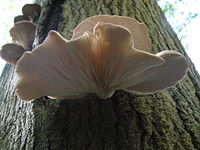
Photo from wikipedia
BackgroundThe identification of microorganisms with excellent flocculant-producing capability and optimization of the fermentation process are necessary for the wide-scale application of bioflocculants. Thus, we evaluated the flocculant-producing ability of a… Click to show full abstract
BackgroundThe identification of microorganisms with excellent flocculant-producing capability and optimization of the fermentation process are necessary for the wide-scale application of bioflocculants. Thus, we evaluated the flocculant-producing ability of a novel strain identified by the screening of marine bacteria, and we report for the first time the properties of the bioflocculant produced by Alteromonas sp. in the treatment of dye wastewater.ResultsA bioflocculant-producing bacterium was isolated from seawater and identified as Alteromonas sp. CGMCC 10612. The optimal carbon and nitrogen sources for the strain were 30 g/L glucose and 1.5 g/L wheat flour. In a 2-L fermenter, the flocculating activity and bioflocculant yield reached maximum values of 2575.4 U/mL and 11.18 g/L, respectively. The bioflocculant was separated and showed good heat and pH stability. The purified bioflocculant was a proteoglycan consisting of 69.61% carbohydrate and 21.56% protein (wt/wt). Infrared spectrometry further indicated the presence of hydroxyl, carboxyl and amino groups preferred for flocculation. The bioflocculant was a nanoparticle polymer with an average mass of 394,000 Da. The purified bioflocculant was able to remove Congo Red, Direct Black and Methylene Blue at efficiencies of 98.5%, 97.9% and 72.3% respectively.ConclusionsThe results of this study indicated that the marine strain Alteromonas sp. is a good candidate for the production of a novel bioflocculant and suggested its potential industrial utility for biotechnological processes.
Journal Title: BMC Biotechnology
Year Published: 2017
Link to full text (if available)
Share on Social Media: Sign Up to like & get
recommendations!